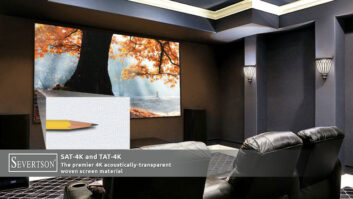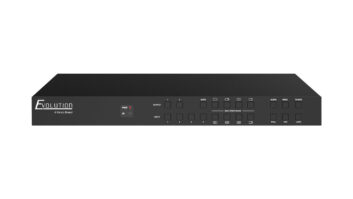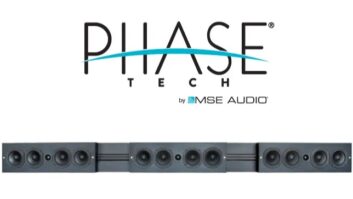Audio/video receivers (AVRs) and audio/video processors (AVPs) are ready for new Ultra HD 4K video sources and 4K displays.
Audio components down to entry-level AVRs are packing HDMI 2.0a connections, getting firmware upgrades to add HDMI 2.0a, and supporting HDCP 2.2 copy protection. With those connectivity options, the AVRs will pass through Ultra HD 4K video up to 60fps, high dynamic range (HDR) 4K video, and video with an expanded color gamut from future 4K Blu-ray players and settop IP-video streamers to 4K TVs equipped with the same connectivity options.
What They Do
The 2.0 version of the HDMI (High-Definition Multimedia Interface) audio/video interface significantly increases bandwidth to 18Gbps from HDMI 1.4’s 10.2Gbps and supports multiple enhancements, including 4K at 50/60 fps, not just up to 30fps; up to 32 audio channels; up to 1536kHz audio sample frequency; simultaneous delivery of dual video streams on the same screen; simultaneous delivery of multi-stream audio to up to four users; and support for the 21:9 video aspect ratio used in theatrical releases.
To this, HDMI 2.0a adds support for high-dynamic range (HDR) static metadata referenced in CEA 863.1 to significantly expand the range between the brightest and darkest parts of a picture. It also enables the dark and light parts of a picture to display subtle details often invisible with non-HDR content and screens, gives a more natural look to colors, and helps create a wider range of colors.
HDMI 2.0 and 2.0a also support the ITU’s Rec. 2020 expanded color gamut standard, which currently exceeds the capabilities of today’s displays. Rec. 2020 exceeds Rec. 709’s 8 bits per color, or 256 shades for each RGB color. Rec. 709 delivers a maximum of 16.78 million colors (or 256 red by 256 green by 256 blue). Rec. 2020, on the other hand, stipulates 10 or 12 bits, allowing for more than 1 billion colors and 68 billion colors, respectively, when the sources support it. Support for 8K resolution is also included in Rec. 2020, though the hardware for that doesn’t yet exist.
The 2.2 version of HDCP (High-bandwidth Digital Content Protection) is another prerequisite for AVRs that want to pass through encrypted 4K content from 4K Blu-ray players and settop boxes. Consumers who try to stream protected 4K content through an AVR lacking HDCP 2.2 would get a black screen on their TV.
TVs are already beginning to support HDMI 2.0 and 2.0a, as will future 4K Blu-ray players, including a model shown at IFA by Samsung.
4K Blu-ray
Samsung’s first Ultra HD Blu-ray player features curved chassis to match the company’s curved TVs and soundbars, HDMI 2.0a with HDR support, wireless multiroom audio, 3D, 10-bit color support, UHD upscaling, dual-band Wi-Fi (2.4/5 GHz), screen mirroring, one USB port, Web browser, and optical output. The device also features Disc-to-USB digital bridge, which lets users make a local bit-for-bit copy of a disc, if authorized by the content creator, on USB-connected devices.
By definition, the Ultra HD Blu-ray format will deliver HDR content, high frame rates up to 60fps, and resolution up to 3,840 by 2,160. Like current Blu-ray players and discs, the Ultra HD Blu-ray format will also deliver object-based sound formats.
Players are also required to feature HDCP 2.2 copy protection, support peak 100Mbps peak video bit rates, deliver a bit depth of 10 bits to deliver smooth color gradations, and support ITU’s BT.2020 color gamut, the Blu-ray Disc Association (BDA) has said.
Ready To Go
When the Samsung player and other-brand 4K disc players debut, most current AVRs and many AVPs will pass through the highest quality 4K signals available to a 4K TV.
All of D+M Group’s current Denon and Marantz AVRs, for example, support HDMI 2.0a, HDCP 2.2, 60fps 4K video, HDR, and Rec. 2020 color space, said D+M Group product manager Paul Belanger. That includes Denon’s opening price $279-suggested AVRS510BT, which provides support for those capabilities on three HDMI inputs. “All other Marantz and Denon models support the above on every input,” he noted. “This is not common with our competitors.”
D+M has also provided a free hardware upgrade for Marantz’s flagship $3,999-suggested AV8802A A/V preamplifier and Denon’s flagship $2,999 AVRX7200W receiver to bring them up to the latest HDMI specs, he noted.
For its part, Onkyo shipped AVRs and AVPs in 2014 with HDMI 2.0 and HDCP 2.2 starting at $299 for the TX-SR333, and in 2015, the brand shipped models with both HDMI 2.0 and 2.0a terminals and with HDCP 2.2 starting at $299 for the TX-SR343, said Onkyo USA marketing director Kevin Brannan.
Likewise, Onkyo USA’s Integra brand is shipping AVRs with HDMI 2.0a out of the box along with HDCP 2.2 starting with the $800-suggested DTR-20.7.
The Onkyo and Integra models support Rec. 2020 color gamut (or color space), which is part of the HDMI 2.0 spec, he noted.
The 2015 models feature 18Gbps HDMI to support 4:4:4 color space, whereas 2014 models supported 10.2Gbps HDMI 2.0 and therefore supported 4:2:0 color space, Brannan said.
For its part, Pioneer offers four Elite-series AVRs with 18Gbps HDMI 2.0a and HDCP 2.2. They sit at the top of the Elite series and consist of the $1,000-suggested SC-91, $1,600 SC-95, $2,000 SC-97 and $2,500 SC-99 AVRs. All models feature Dolby Atmos, and the top three are firmware-upgradable to DTS:X.
On August 24, the company delivered a firmware update to upgrade the $450 Elite VSX-45 and $700 VSX-90 to HDMI 2.0a. Firmware updates were also issued then for two mainstream-series models, the $399 VSX-830 and $599 VSX-1130, which adds Dolby Atmos.
All of the Pioneer models feature 18Gbps HDMI. In Yamaha’s 2105 AVR lineup, HDMI 2.0 and HDCP 2.2 start at a suggested $299 for the 5.1-channel RXV379. This year is Yamaha’s first year with AVRs and AVPs supporting HDMI 2.0 and HDCP 2.2. It wasn’t certain at press time whether the HDMI connections support HDMI 2.0a.
For its part, Sony offers two AVRs with HDCP 2.2 but without HDMI 2.0. They are the $499 STR-DN860 and $599 STR-DN1060. Both feature HDMI 2.0 with HDCP 2.2 copy protection and no Dolby Atmos or DTS:X. HDMI 2.0a and the two surround formats, however, could put in an appearance at the CEDIA Expo.













